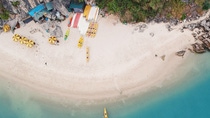Construction
Safeguarding against climate change: How cities respond to the need of coastal protection
As climate change continues to intensify, how will Asia contend with current and future environmental challenges? We take a look at the solutions of three Asian countries, and how the cities of today and tomorrow can build a sustainable future for all.

As global temperatures rise, so does a host of other components. All around the world, we bear witness to melting polar ice caps, glaciers and land ice, resulting in climbing sea levels that adversely affect urban communities. With six out of ten of the world’s largest cities situated on coasts, life as we know it, will inevitably change.
By 2050, scientists predict that:
• Global temperatures will rise up to 2°C
• Sea levels will rise up to 0.5 meters
• Up to 570 cities and over 800 million people will be affected by coastal flooding, with 70% of those affected living in Asia
• Costs of coastal flooding: US $1 trillion

Weathering the Storm
With fishing farms, trade ports, energy generators, water sanitization plants and tourist hubs situated in and around coastal cities, these areas form the bedrock for much of the world’s essential services and resources. However, these very cities are also vulnerable to storm surges, tidal waves and powerful typhoons, which have destroyed acres of land, displaced citizens and caused massive economic losses.
When Hurricane Sandy swept into New York in 2012, the aftermath was devastating. The coastal floods that followed led to 44 fatalities and 90,000 damaged buildings that caused over 2 million people to lose power. The disaster also disrupted commercial activity, costing up to US $70 billion.
And with more than three million people—mostly in Asia—at risk of experiencing coastline flooding in the coming years, the impetus to create and safeguard critical infrastructure becomes all the more pertinent. Here’s how three other countries are combating the challenges of flooding.
Fortifying Cities
CHINA
From 1989 to 2014, China saw 7,000 fatalities and direct economic losses of US$ 77 billion due to frequent coastal flooding. As the country with the highest population vulnerable to shrinking coastlines, China has continually invested in initiatives and measures to protect its coasts, rivers and populace.
For example, 520km of protective seawalls were built around Shanghai to reduce its exposure to rising seas, and the megacity installed large, mechanical gates to regulate overflowing rivers and early-warning disaster systems to signal impending calamities.
Its most significant project, however, is its ‘sponge city’ initiatives aimed to combat regular flooding from heavy storms. Consisting of ecologically friendly measures such as permeable pavements, rain gardens, artificial ponds and wetlands, 30 Chinese cities will ensure that 80% of their urban land includes sponge features by 2030.

SOUTH KOREA
Beset by droughts, floods and pollution, the Four Major Rivers Restoration project began in 2008 to revitalize four of South Korea’s largest rivers. Multiple facets such as installing weirs, using cutting edge water management technologies at multi-purpose dams, elevating the banks of existing agricultural reservoirs and creating floodplains went into this five-year development.
South Korea has also invested in other long-term and sustainable floodproof systems across multiple coasts. For instance, revetments built with Elastocoast at South Korea’s largest national park—Gwanme-do Beach—in 2012 have withstood the test of time and several typhoons. The revetments’ eco-friendly features have also enabled flora, fauna and pine groves to thrive, minimizing disruption to the natural environment.
THAILAND
Thailand has 23 coastal provinces, homing 11 million inhabitants. However, with a coastal erosion rate of 5 meters per year, the country is straddling a precarious edge. If little is done, up to 1.3 km of shore will be lost in the Bang Khun Thian district in Bangkok in 20 years. Across different coastal communities, governments work with localized groups to enact coast protection measures. These range from growing and preserving mangroves to building sea walls and bamboo barriers—each measure tailored to meet individual and specific coastal community needs.
On a broader front, Thai planners, lawmakers and researchers have also mapped out a plan to bolster the Gulf of Thailand’s coastal defenses from rising sea levels and monsoons. This includes a green barrier belt made of planted mangroves, super-levees and an 88 km water gate that opens and closes with the tides.
Stemming the Tide
Across borders, governments are seeking and investing in long-term, sustainable solutions with integrated ecological and green features to fortify cities against decades, if not centuries, of climate change.
This is also in line with recommendations from experts. Industry leaders propose a two-pronged approach to overcoming flooding: (1) building physical infrastructure—such as seawalls—to keep water away from citizens; and (2) implementing preventive measures to keep people away from the water—such as early warning systems.

The Future of Cities
With time, technology, and comprehensive analysis, humankind has observed the planet’s transformation while calculating projections for the future. While climate change may bring about the tumultuous disorder—destroying infrastructure and disrupting lives—governments, together with urban planners, industry leaders, and conservationists, have the power to work together to formulate and implement solutions that will not just protect our existing land, but the fabric of society and its communities. How will the cities of tomorrow look and feel like?
The answer lies in the protection of our environment today.
Consult with an expert
Self-service solutions:
